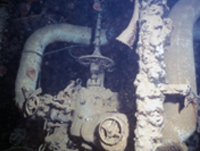Taking the Next Step in Wreck Diving
Add a whole new dimension to your adventure!
For many years people have enjoyed the beauty in wrecks. Some enjoy the glimpse into history; for others, it is the research of the wreck and the part it played in the maritime industry; others simply just enjoy the abundance of life that this manmade structure attracts. Wrecks are in nearly every body of water, fresh and salt alike, and vary in size from a small pleasure craft all the way up to an aircraft carrier. In some locations wrecks are the attraction, such as: Chuuk Lagoon, the eastern seaboard of the United States, the English Channel, the Great Lakes and the list goes on. For some divers staying on the outside of the wreck is all they desire but others…they want to explore and see what’s on the inside.
While the outside of the wrecks present some potential dangers – cuts from sharp steel, being pulled into the wreck through an opening (typically only when there are large waves, groundswells or currents), possible entanglement from lines on the wreck for fishing gear – going inside requires very specialized training. To gain access to most wrecks, divers have to take a boat. Divers are pretty familiar with boats and their layout while they are floating in their upright position. The problem is…most wrecks don’t land like this. Wrecks can land on their sides, upside down, even vertically or ripped in half by wave action or during the sinking process. All of these different positions present unique challenges to the diver, and an experienced TDI instructor will help you gain the knowledge needed to navigate these challenges.
A TDI Advanced Wreck course builds on the knowledge and skills gained during a basic wreck course. It takes the information learned, such as: wreck charting (noting different depths on the wreck, entries, exits, orientation, etc), laying line and air management and extends them to going inside the wreck. Unlike being outside the wreck, there is no direct path to the surface, and in most wrecks there is zero or limited ambient light. These two factors alone need to be seriously considered. Your TDI instructor will also teach you the research skills you need so you have a better understanding of the wreck, its design and how long it has been resting on the bottom.
There are few diving activities more rewarding than wreck diving, especially if you have an interest in history. Having the knowledge of wrecks is also very beneficial for those that are interested in spear fishing or for photographers. You never know where that fish might end up or where the best angle is for the cover photo shot.
Find an Instructor in your area to get started!



Dodaj komentarz
Chcesz się przyłączyć do dyskusji?Pomóż nam się rozwijać!